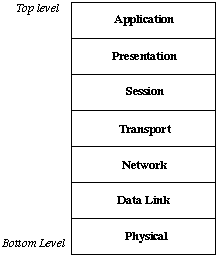


Next: TCP/IP
Up: Networks How
Previous: Local Area (LAN) and
As we have pointed out already there is a real need for a communication
protocol to established. There is clearly a need for a standardised
protocol in the global context on networking -- otherwise the Internet could
not exist in its current form.
Networking protocols need to be established for low level computer
communication up to how application programs communicate. Each step in
this protocol is called a layer.
The International
Standards Organisation (ISO) defines a 7 layer model for network
communication protocol. The model is more formally called the Open Systems
Interconnection (OSI) model. This should exist in any network.
The advantage of breaking down the protocol into layers is twofold:
- Each layer can be regarded as a black box.
- Well defined inputs and outputs exist, but
- The Inner workings of the layer can be regarded as being independent
- Thus, New versions, updates or better methods can be written
without affecting the whole system.
- Network is Future Proofed to a great extent.
- Benefits passed on to whole network.
- Communication need only take place at the layer appropriate for the task.
The OSI model consists of 7 layers. The seven layers must be organised in the
specified order:

Figure: The OSI 7 Layer Model
The function of each layer (from bottom to top) is:
- Physical
- -- The interface between the medium and the device. The layer
transmits bits (ones and zeros) and defines how the data is transmitted over the
network, what control signals are used and the mechanical properties of the
network (Cable size, connector for example.
- Data Link
- -- Provides low-level error detection and correction. For
example if a packet is corrupted this layer is responsible for retransmitting
the packet.
- Network
- -- Responsible for routing packets of data across the network.
For example, a large email file will be divided up into packets, each
packet addressed and sent out at this layer.
- Transport
- -- An intermediate layer that higher layers use to communicate
to the network layer. This layer hides the complexities of low-level networking
communication from the higher levels.
- Session
- -- The User's (transparent) interface into the network. The layer
manages the ``current'' connection (or session) to the network. Note: In
packet-switched network a full-time network connection does exist, even though
it may seem so. The Session layer keeps the communication flowing.
- Presentation
- -- Ensures computers speak the same language. They convert
text to ASCII or EBCDIC form and also encode or decode binary data for
transport.
- Application
- -- The programs you use directly may need to communicate. E.g
a file transfer or email program.
Some Example Internet Protocols
- Token ring -- low level network message passing.
- Telnet
- File Transfer Protocol (FTP)
- Archie -- FTP search
- Simple Mail Transfer Protocol (SMTP), Post-Office Protocol version 3
(POP3), IMAP -- email protocols
- Gopher - menu-based information, veronica
- WAIS - wide-area info server
- HTTP -- Hypertext Transfer Protocol basis of World Wide Web



Next: TCP/IP
Up: Networks How
Previous: Local Area (LAN) and
Dave Marshall
9/28/2001

